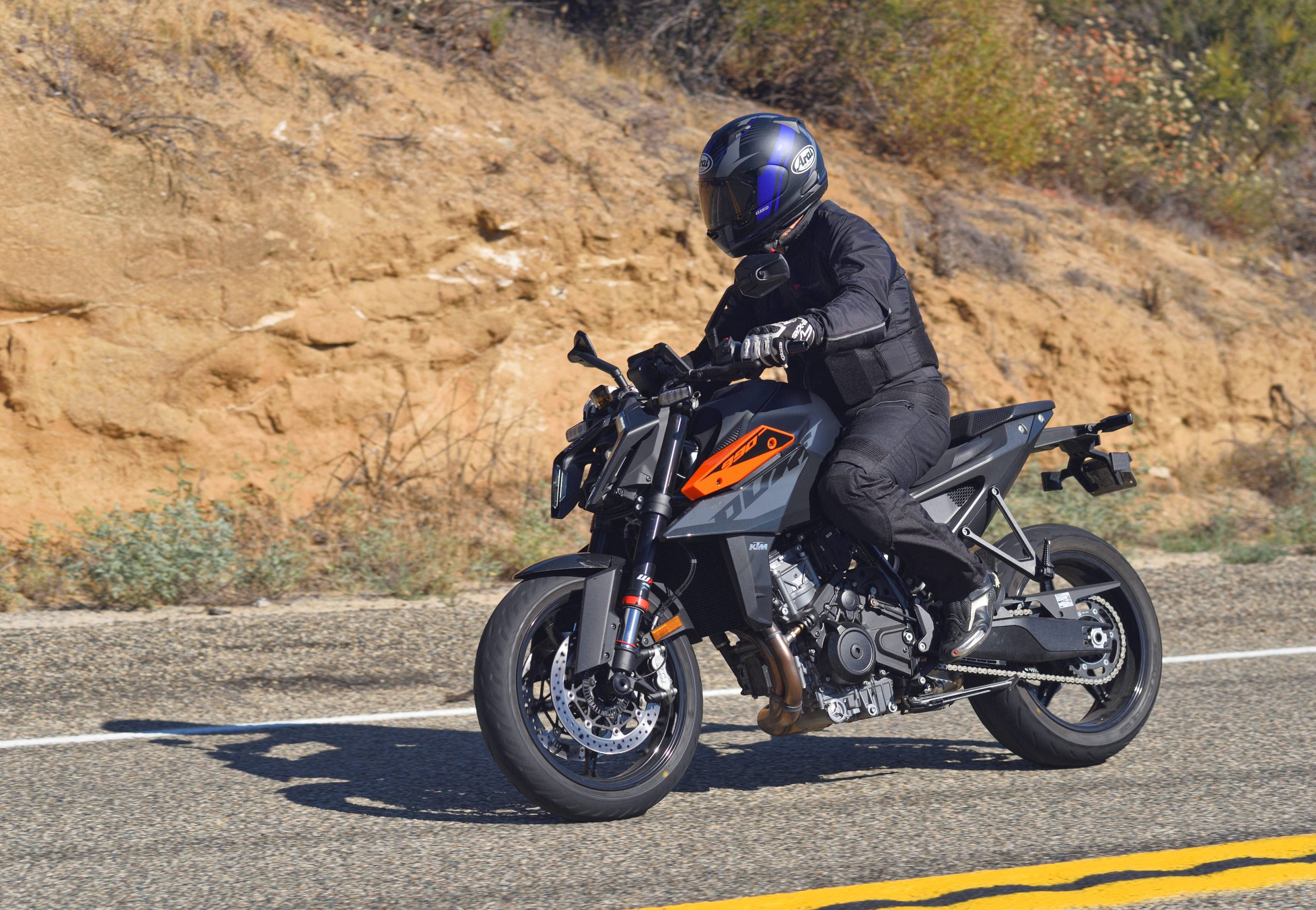
KTM has a well-deserved reputation for making exciting naked bikes that are popular with motorcycle enthusiast. One of MD’s all-time favorites is the 890 Duke we tested a few years ago. We loved the engine performance, which provided big mid-range power to catapult riders out of corners, and quick, intuitive handling. Riding that bike was a blast.
For 2024, KTM has a new platform to replace the 890. First up is a standard 990 Duke (we think an R version will be coming shortly), that MD has had the opportunity to put numerous miles on, and take to a track day.
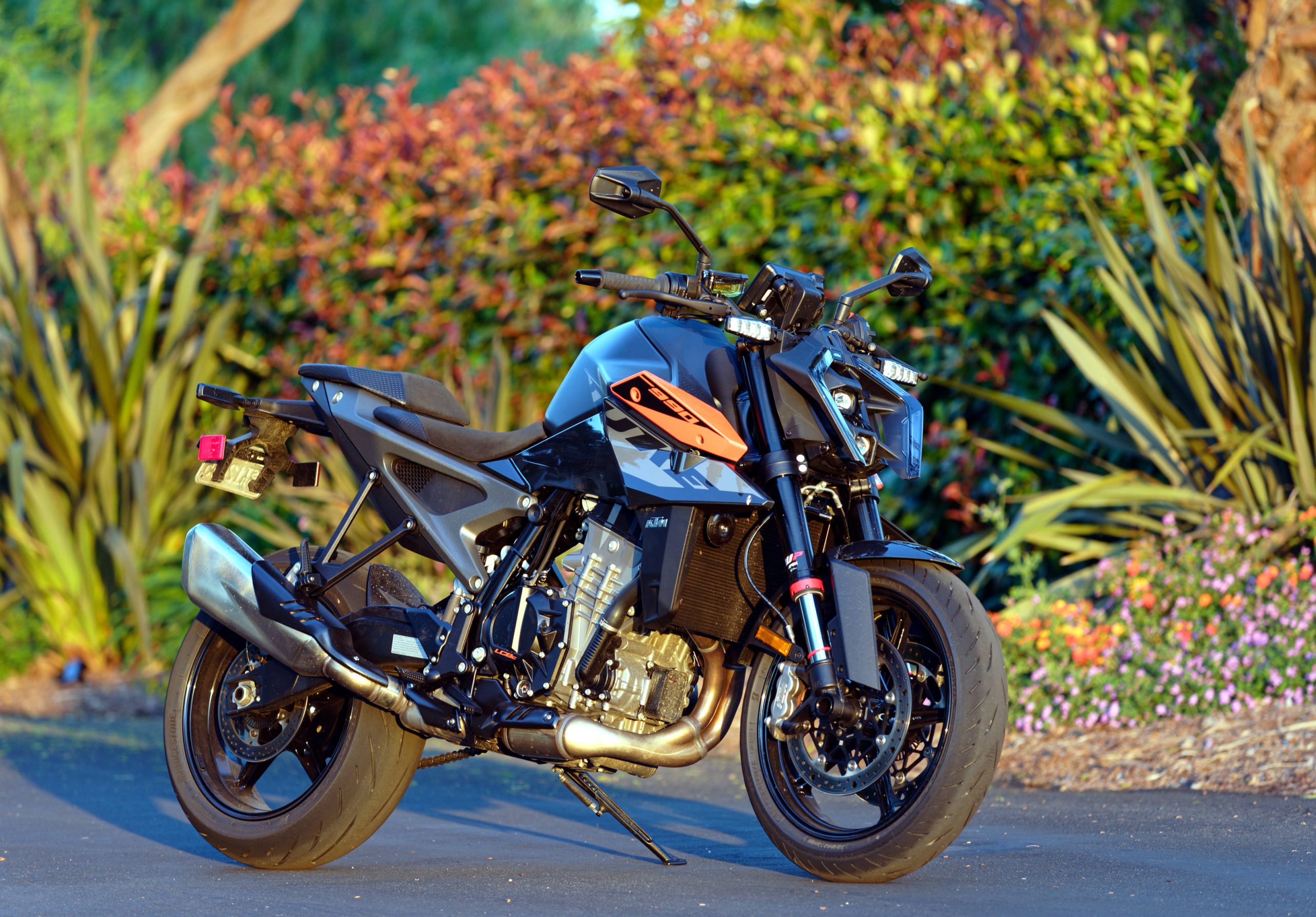
KTM points out that the new 990 is, essentially, all new with over 90% of the parts not found on the previous 890. Here is how KTM describes the 990 Duke highlights:
- Two new colorways celebrate 30 years of DUKE.
- New LC8c 947cc DOHC engine with PASC slipper clutch has been reworked inside and out to deliver even more asphalt-ripping power from a compact build.
- New, wider radiator for improved cooling.
- New ultralight tubular Chromium Molybdenum steel frame with new swingarm pivot adds more cornering stability.
- New stainless steel exhaust system offers centralized mass, great sound, and tailor-made looks.
- Cast aluminum subframe for weight savings houses the redesigned, high flow airbox.
- New swingarm is completely redesigned to be lighter while providing more stability and comfort.
- Selectable ride modes including Sport, Street, Rain, and optional Track and Performance modes for easy changes to engine and MTC character while optional Quickshifter+ enables clutchless up- and down-shifting.
- New optional Track mode offers 10-level adjustable traction control plus new lap time and telemetry features.
- New 43 mm open-cartridge APEX forks by WP for excellent response and stability offer 5-step adjustability.
- New high-quality, gas-assisted WP APEX shock now with 5-step adjustability to match the fork performance.
- Powerful brake system featuring twin 300 mm floating front discs with 4 piston radially mounted calipers.
- New, lighter LED headlight and LED daytime running lights with new Coming Home light feature.
- Multifunctional dashboard with full-color 5” TFT display is bright and clear and features new pictograms.
- Optional Motor Slip Regulation (MSR), Cruise Control, and KTMconnect for smartphone connectivity.
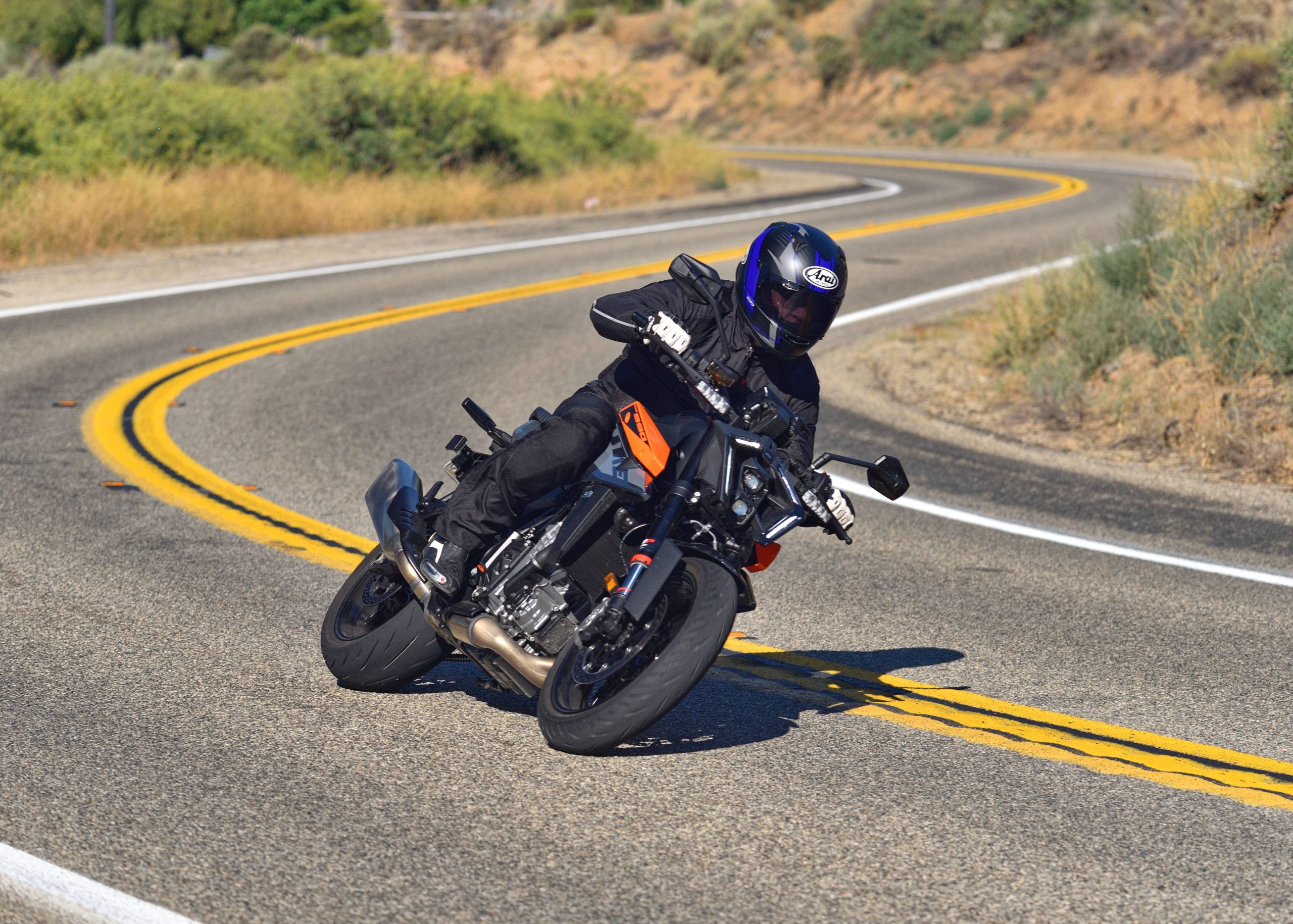
Although still a parallel twin, displacement has now been bumped to 947cc. KTM claims only a couple additional horsepower over the 890 R, but torque is up and broader in delivery.
Claimed dry weight is just 394 pounds, and the new wheels are lighter – borrowed from the 1290 Super Duke.
KTM has done something interesting with the suspension. Unlike the base model 890 Duke, the 990 Duke comes with adjustable forks. Both rebound and compression can be adjusted, but only five clicks of adjustment. KTM says each click has a much greater impact than prior adjustable units. The rear shock has spring preload adjustment and rebound adjustment (again a five-click range).
The standard selectable ride modes include three options – Sport, Street or Rain. Optional modes are Track and Performance, and also optional is a quick shifter feature. In the Track mode, the rider can select from 10 levels of traction control, as well as a lap timer. All of these options are available for a trial period of just short of 1,000 miles after which they must be purchased from your local dealer.
The new motor is housed in an entirely new frame that is stiffer than the frame holding the 890. A new swingarm is actually less stiff to optimize traction and feel. The new swingarm pivots from inside the frame rails of the main frame structure, rather than outside as in the previous 890.
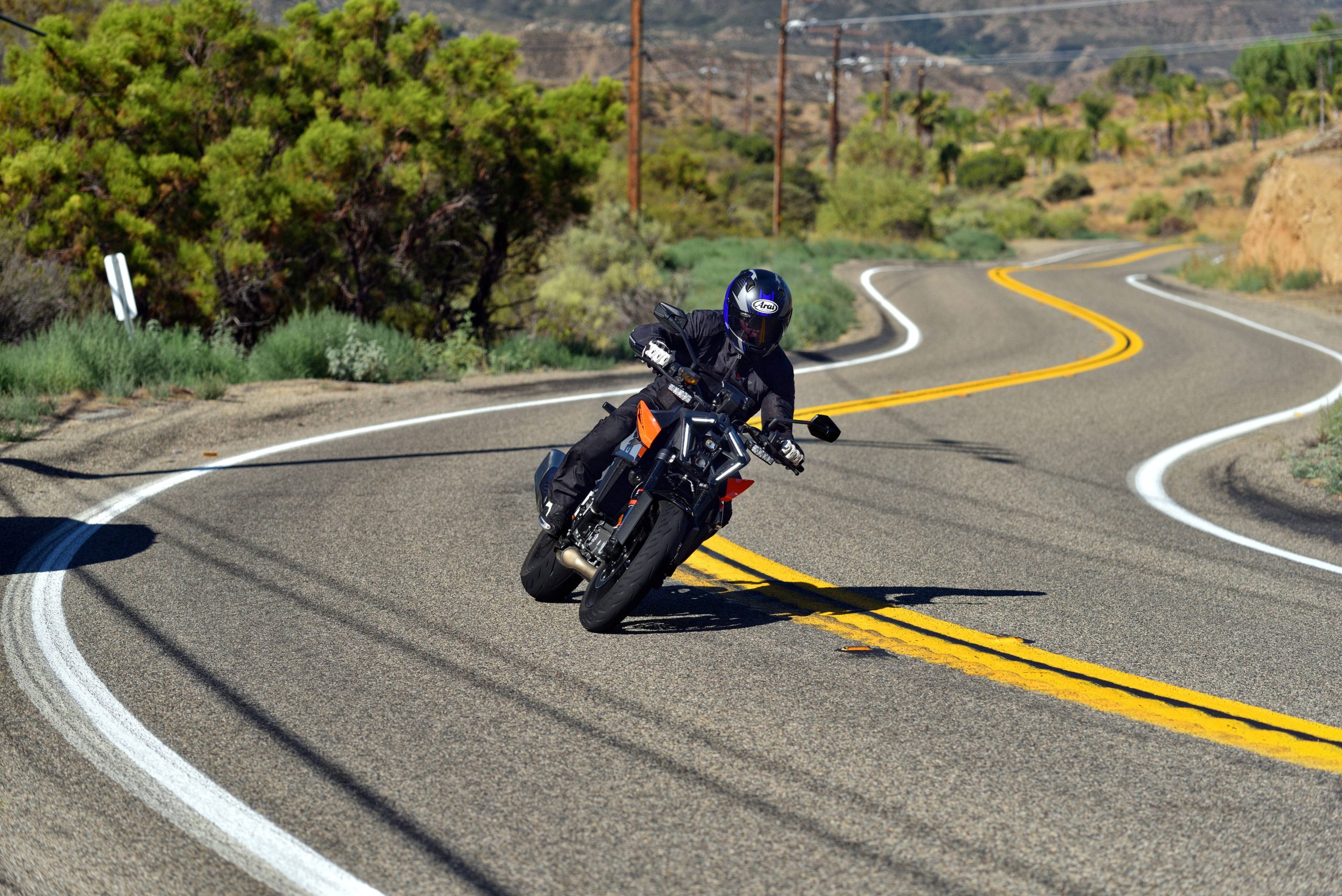
The new 990 Duke offers comfortable ergonomics. Very upright in the reach to the bars, and a more comfortable seat than we recall on some prior KTM street models. Footpeg placement allows reasonable legroom while still providing decent ground clearance while cornering. The rider has a direct view of the large 5″ TFT display that is even easier and more intuitive to use than the similar display found on the prior 890 Duke.
The brakes include two 300mm front discs held by lighter carriers. Four–piston calipers grab the front discs.
We thought the 890 Duke had plenty of power for the street, and the 990 Duke simply adds a bit more power and torque. Pulling away from a stop reveals a linear power delivery that is extremely meaty from low RPM levels, yet revs out strongly on top. Once again, just about the perfect street motor.
Twisty roads reveal the real reason you might consider the new 990 Duke. The handling is simply phenomenal. Very light and nimble turn in combined with excellent stability. Mid-corner bumps do not upset the chassis, and the bike tracks exactly where the rider points it.
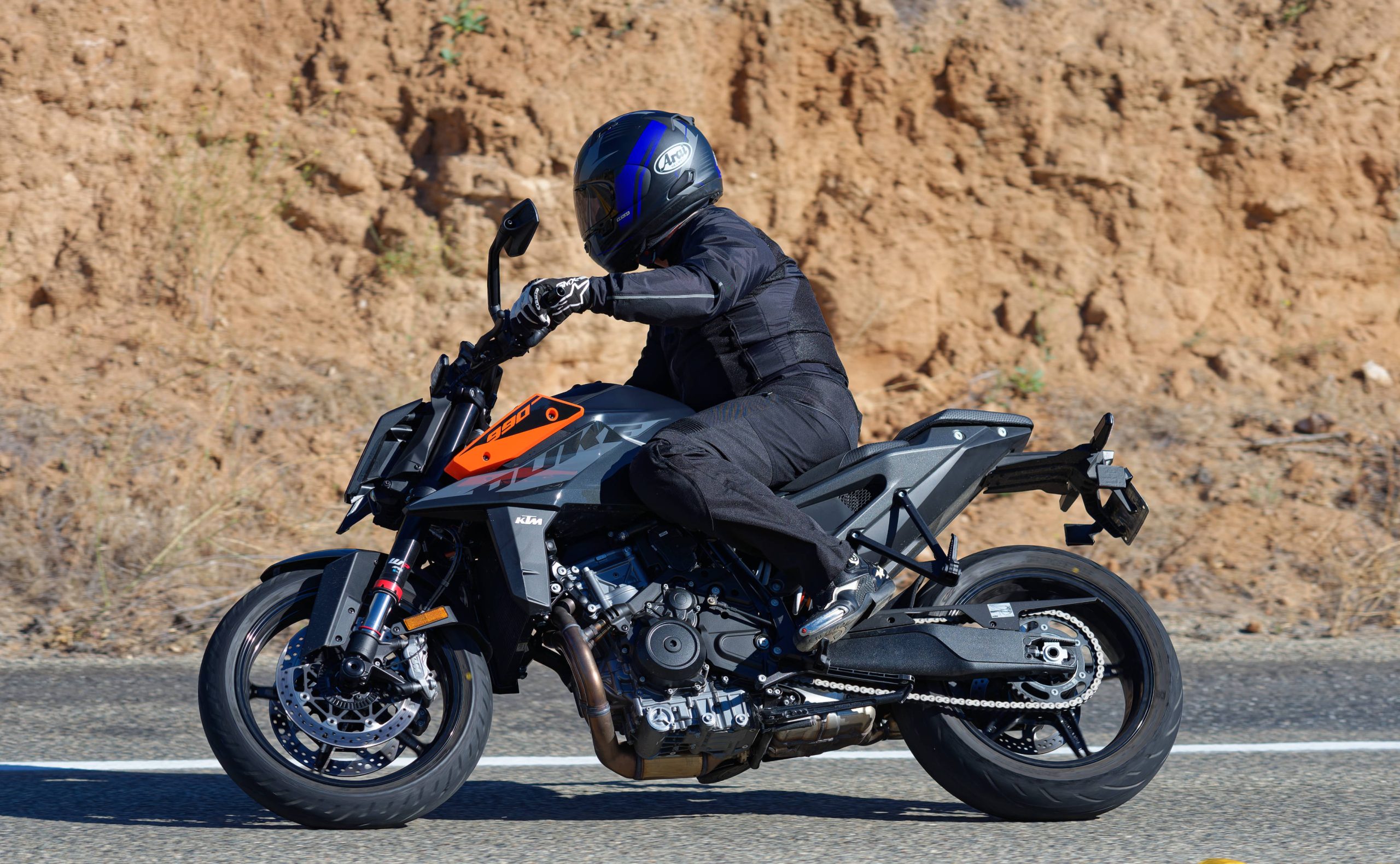
You feel like you can’t miss your apex on this bike, because the steering is so accurate and intuitive. The careful balancing KTM did with the frame stiffness and the swingarm stiffness no doubt contributes to this, but the stock suspension also strikes an excellent balance between firmness, for sport riding, and comfort.
The brakes work surprisingly well. This is not the fancy Brembo caliper set found on the 890 R, but the brakes offer much better power and feel than the old base model 890.
Our test bike not only had the optional Performance and Track modes, but also the Quickshifter+ system, which seemed to work better than the quickshifter found on the old 890 Duke models. In general, we had no problem with the six-speed transmission, and gear spacing seemed appropriate for the broad spread of power.
Indeed, most corners could be exited in a couple of different gears without sacrificing thrust. Opening the throttle resulted in a smooth transition from closed throttle, even in the Performance and Track modes.
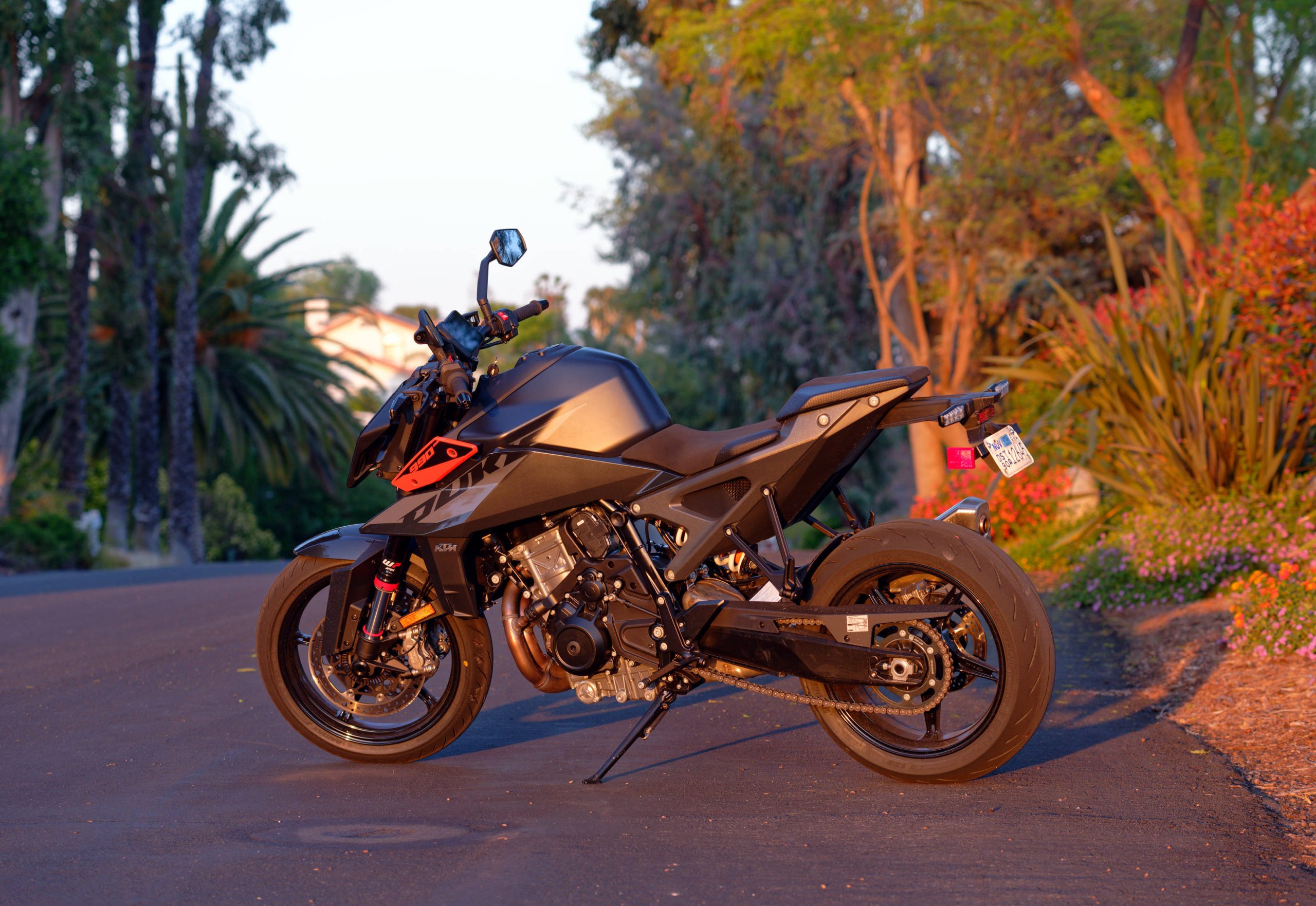
With the new, adjustable suspension and larger displacement engine, the base model 990 Duke, in many respects, offers the performance of the old 890 R. The new chassis (the new frame and swingarm in particular) seems like a big step forward. Drawing on its road racing experience at the World championship level, KTM has found some real magic enabling the phenomenal handling this bike offers.
We did take the bike to a track day, where the same accurate steering stood out. At track speeds, the suspension is too softly sprung, however, for a larger, faster rider, but this is to be expected with a bike that is set up to perform comfortably at street speeds.
Although we cannot fault the handling, we would have liked a little better feel and feedback from the front tire contact patch. This didn’t hold the bike back significantly, but it is something we wanted to note.
The 2024 KTM 990 Duke is available now in U.S. dealerships at an MSRP of $12,500. Take a look at KTM’s website for additional details and specifications.
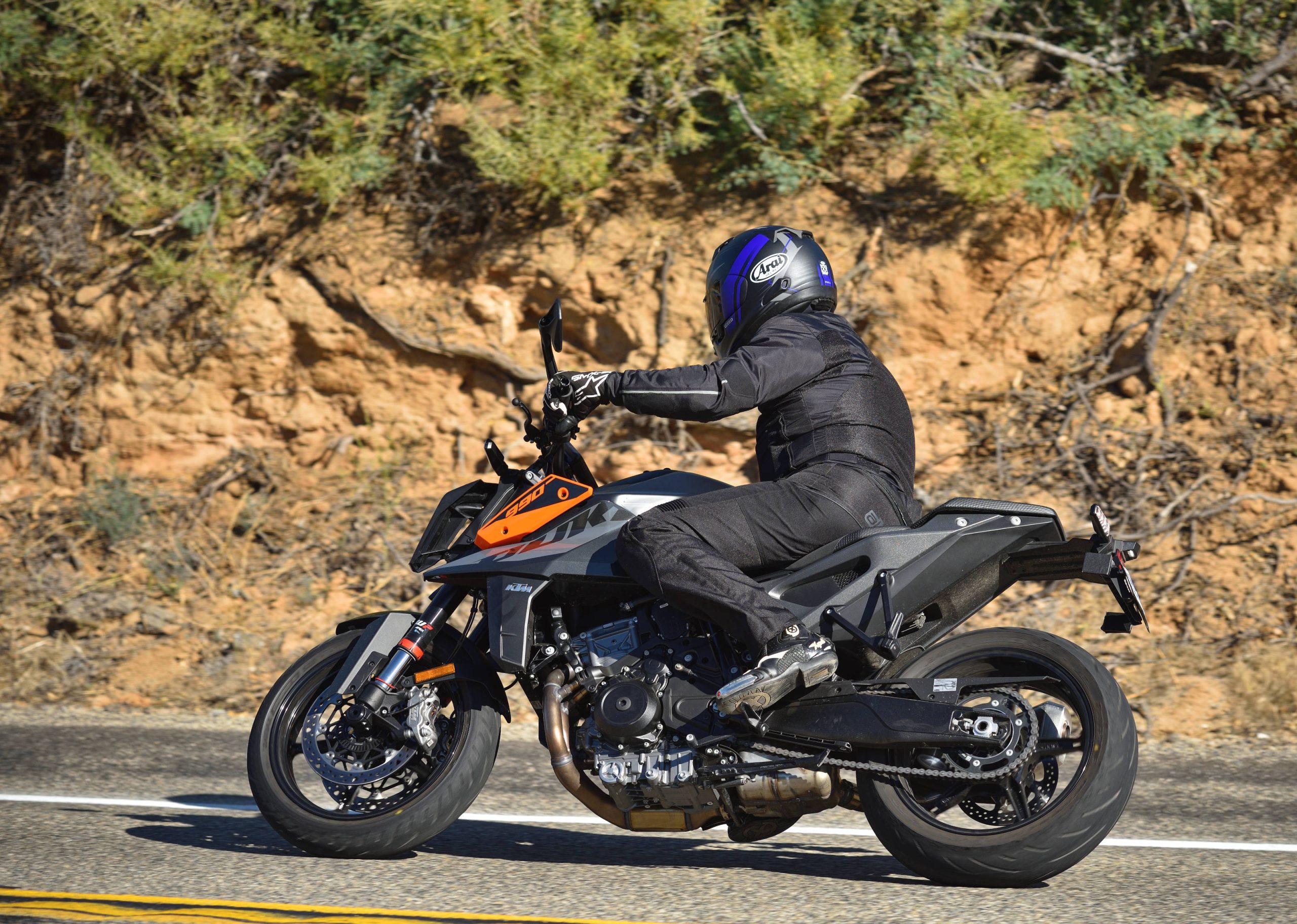






Until KTM develops a Japanese level of reliability, stay away…far away. At least the other Euros have brand cache and (in the case of Ducati)improved reliability.
My 690 has been more reliable than two Honda thumpers I have had. GB500 ate three top ends and one bottom end between 19,000 and 50,000 miles. XR650L alternator rotor came off the end of the crank around 20,000 miles. 23,000 miles on my Duke and it still burns no oil and has over twice the acceleration of those Hondas. I did have to replace the clutch slave piston seal with an o-ring.
So a 950.
I would never own a parallel twin of such displacement, but also, why do they put it on such an UGLY motorcycle?, who is the designer of such a monstrosity?
Curious, why not a P-twin of this size? They seem like a sound idea to me.
Any machine that uses 10W 50 and runs at high RPM should change their oil every two or three thousand miles. The polymers allowing the wide viscosity range sheer faster than oil. So I heard on the internet. Maybe yes maybe no. If you have one send an oil sample in on your next drain and find out if the viscosity is within spec.
There is a measurable change in oil viscosity after only 1000 miles of use.
Yes – wide viscosity range oils are less effective at maintaining wet and slippery over time than lesser range spread multi oils. I always used 20W 50 in my summer desert rides over 30 years with no problem, ( same bike ) however changed the oil after no more than 2000 miles.
While on the subject, Synthetic Blend oils are a rip off. A reasonable assumption is that they are 50% Syn and 50% conventional oil. Nope. The government only requires 10% Syn for a Synthetic Blend to be called that. Guess what the consumer gets for almost the same price as full Synthetic.
If you want 50/50, mix your own.
I’m gonna go out on a limb here. And I apologize to Dirck if I am making a site rules boo boo. But really, Rotella T5. One and done for anything that doesn’t new a 0W something. A zillion pieces of heavy equipment, over the road trucks, boats, old cars, ski boats, anything with a Rekluse clutch, dirt bikes, air colled anything over decades… can’t be wrong. Things that work hard every day forever use this oil. And they continue to last forever. Questions?
Whatever, it comes in five gallon buckets at many locations. And you get to keep the bucket, unless you need it for drain oil.
I’ve run the T6 5W40 or equivalent. There are several brands. There’s no magic here. Diesel oil’s additive package works well in the motorcycle application and the trucking industry has zero tolerance for less than excellent oil performance so it’s really hard to find a bad one.
I would caution anybody to research the use of Diesel oil in a gasoline engine for a couple of reasons.
Diesel engines can not achieve high rpm near what gasoline engines can, so the oil manufacturers do not have to design the anti foaming / frothing in. Diesel is also a very dirty combustion cycle that requires a substantial cleaning component in the oil, which can be too much for catalytic converters. Even with modern Diesel engines and high pressure injectors the particulate emissions get into the oil. Don’t forget, heavy equipment Diesel engines are high torque/load worlds of fire and kaboom,not whee and zoom 10,000 rpm motorcycles.
From what I’ve read about it, the additive package that make it suited for diesel use make it also favorable to motorcycle use. While a motorcycle engine may spin faster, shearing and pressure loads are higher in a diesel. Because the oil is shared between the engine, transmission and clutch a motorcycle engine is also a more dirty environment. This has been done for decades and I have never been able to find any evidence of anyone having an oil borne engine issue due to running these oils in motorcycles.
AS I wrote, caution and research. Unless the Diesel oil says on the container it can be used in Gasoline engines, do not assume it is ok, you might be experimenting. I think there is a letter code S indicating OK, or plain English. All Diesel oils are not the same.
Regarding clutch wearings and broken teeth, not the same as extreme combustion products.
Don’t know about oil but gasoline has about 20 different additives, all of which do different things, including detergents.
The final test is a look see when taking apart an engine.
on a twin, two heads is better than one.
Until it’s valve inspection/adjustment time. – A V4 rider…
Why? Modern parallel twins are not using the old Ninja 250-etc drone firing order.
I had so much hope for the parallel twins. I thought that they were going to make better street bikes. Unfortunately, except for KTM, they all seem to be a Gen one and done engine for budget bikes. KTM is odd in that they made the 790 with a lot of room for expansion, obviously because it’s a 990 now. And they killed the smaller one that they were developing. I was kind of hoping that one was going to hit the sweet spot.
You can buy KTM’s small p-twin on a few models from CFMoto (who makes the Duke 790 today). They’re supposed to have pretty good.
If I were to fuss with a current parallel twin I would probably do something with the Yamaha 700. I rode one in Europe for thee days several years ago. The CP2 engine has a stellar reputation for reliability and it is not ride by wire. My issue with it is that they never made an R version. It would be nice if Yamaha would have made an expensive 700 with a dry sump and quality suspension and brakes. And of course considerably less weight. But they don’t. So if I were to buy a new off the rack bike I would opt for a Kramer single. Lose the bodywork, add some lights and find a quieter pipe. Bob’s your uncle. And he’s WAY back there on some heavy street bike.
I’ve heard lots of good things about Yamaha’s twin. There’s an FJ07 Tracer available in Europe that looks really good. If were available here I might even swallow the dealer fees to purchase one new. Been giving the BMW F800’s a look lately. Similar bikes and good used ones seem easy to find.
The wife wants to ski Europe the winter of ’25’ 26 and then ride around Sicily for a while. We would have to rent something. The BMW is probably what is in the rental fleets over there. I haven’t looked into it. It’s not super easy to do. When I lived in Europe I had to leverage the fact that I was a resident to rent a Honda CB1000R, the naked bike, in NL and have my friend ride my bike. In France I found a Yamaha dealer who would rent me and a friend a MT07 for me and a 900 Tracer for him. His 18 year old son rode my bike. French 18 year olds are not allowed to ride regular street bikes. American kids with a motorcycle endorsement can. But nobody will rent them anything. I was surprised to find that the 900 Tracer was basically a three cylinder clone of the ’03 Multistrada that I had over there. The whine that the engine made however was an unwelcome feature, at least for me.
Do you know what is better than that Yamaha twin? KTM’s 690 single. I don’t get the disdain for singles and the love of twins. I’ve never owned a twin (other than my two-stroke twins) that were better than a single, or triple or four for that matter. Sure, some twins are good for “character” but they are a total compromise.
I usually don’t pay much attention to complaints on social media regarding problem areas, but there sure seems to be a lot of folks out there with cam problems on KTM parallel twins. Any comments on this? I can live with the hideous headlight. But cams that wear out within 6 months … that’s a non starter (if true).
KTM bikes seem to keep getting better and better – and this one reins in the wonky styling to the point where I’m like Huh I could actually consider this – but the reliability complaints have not gone away even now…I’d trust a Ducati quicker than a KTM in this department, and that’s saying something….
Not sure which bikes are having a problem, but I understand that KTM has agreed to warranty certain Cam problems in earlier generation parallel twins beyond the normal warranty expiration date. I have a 2019 790 Adventure with over 10,000 miles on it and have experienced no valve or Cam issues. This 990 is a new generation engine. I doubt KTM would have ignored a known issue in the earlier generation motors when it designed the 990, but I don’t test these bikes long enough to comment on possible long-term issues.
Thanks for the ride report Dirck, there’s no doubt that the 990 Duke is just a hoot to ride. My concern is that it could be a nightmare to own. I really like the entire KTM line, and even have the 890SMT on my short list, but I’m not interested in having a long distance relationship with a dealer (30 miles away). Maybe as KTM transfers its production to China quality might improve. But I’ll probably let others take that chance…I’ll likely stick to a brand that is known for quality.
“Maybe as KTM transfers its production to China quality might improve.” Surely you jest, Sir.
No, he does not. The Austrian KTM engines (including the 1st gen 790 twin) have been notorious for issues that just aren’t seen on premium motorcycles. China is an industrial giant who’s motorcycle brands build bikes in volumes many times that of western manufacturers. They are building whole premium motorcycles and scooters for European brands and have for a while and I bet you cannot name any of them based on their reputations for reliability.
I like to remind people who have this opinion of Chinese manufacturing quality, every piece of “cheap chinese junk” you’ve ever experienced was sourced and approved by an America (or wherever you’re from..) product manager.
Been a long stretch since a motorcycle review. Welcome back.
I had a 1290 Super Duke GT for 4 years with zero problems. If you are looking for a state-of-the-art bike this could be it. I replaced the SD with a Multistrada that has also been a trouble free rider. I like it except the weight when moving it around in the shop. My advice, ride the bikes you are considering, then decide.
Who is “designing” the headlights there? JFC, they are HIDEOUS, truly awful.
Apparently KTM is having some financial problems. I kind of feel like I should do my part and buy one. Looking at their website I couldn’t help but notice that they are still selling two 2020 Xbow modles. But I’m not a car guy, I don’t want anything that is ride by wire, and I still like my two strokes carbureted.
Possibly not possible to find a fault with this bike. Maybe cosmetics aren’t for everyone – some like red, not orange. But if you’re in for a naked liter bike that does it all, look no further. Get another set of wheels and take it on dirt roads.
Sure, right until the ECU or dash take a shit on you, or the head gasket starts leaking. Then you get to enjoy KTM’s sparse dealer network and shitty parts pricing/avail. And let’s never forget the fact the KTM charges you to unlock parts already on your bike.
Hard pass.